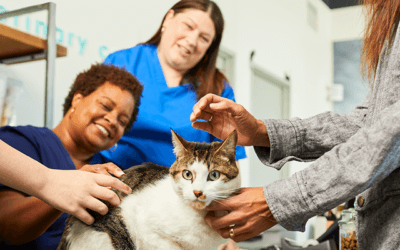Modern-day KPIs or key performance indicators have been widely used in business since the early 1900s. While the veterinary industry is no stranger to the standard KPIs like revenue and patient visits, it’s likely missing one of the most important KPIs: team wellbeing.
“But it’s impossible to measure!” you say.
Not according to Certified Veterinary Practice Manager, Jamie Davis. We sat down with Jamie to get the scoop on her team wellbeing case study where she developed a plan to inspire, measure, and move the needle on team wellbeing within her veterinary hospital.
Preliminary results are promising, so read on.

Team wellbeing case study
Q&A with Jamie Davis, CVPM
1. Where did your idea for team wellbeing as a KPI come from?
“My idea for team wellbeing KPI was born from my feeling that wellbeing in veterinary hospitals is one of the most overlooked necessities for a healthy team. Being in the field for the last 20+ years and seeing how often people are sacrificing themselves for their work makes me want to change things. I want people to be able to live out their dream of taking care of animals by giving people the tools and support that they need to take better care of themselves.
I’m also a HUGE data nerd and believe in the value of measuring everything we do. Tracking something like this is not easy and takes a little more thinking outside the box. However, I know that for an idea to really gain traction in our industry, we not only need to be talking about it, we need a way to track our efforts if we really want it to stick.
When I brought this idea to my team I never imagined how well it would turn out. No one on our team had ever experienced a structured program focusing on themselves and getting rewarded for it.”
2. Tell us a bit about the 6 steps you outlined for focusing on team wellbeing.
“Everything I do starts with the why because I believe it has the power to inspire people. If you miss this step, you are just telling people what they should do and requiring that they follow you. That doesn’t sound very engaging, does it? Now imagine a group of people that are impacted by an idea and feel inspired to follow that idea. Those people are going to take ownership and go after it with dedication and passion.”
“Just like any tracking, you need to define activities to give your team direction. Otherwise tracking goes off the rails. We started by looking at wellness activities that were specific and varied enough to appeal to everyone. The AVMA’s 100 Healthy Tips to Support a Culture of Wellbeing is a great resource. DO NOT pick from just one area though. You need a variety to keep all team members engaged.”
“When we are responsible for tracking our performance, we are more focused and connected with the activity. The physical act of sticking a sticker to a chart is like a mini celebration every single time. If we are going to track something, why not make it enjoyable! Especially when it is something as connected to our team as wellbeing.”
“You have to visualize what could be impacted by a happier and healthier team. There are NO KPIs that are mutually exclusive. Team wellbeing is no exception. This is why we brought together more than one KPI to track the overall team wellness KPI, including gross revenue, average client transaction (ACT), client satisfaction ratings, sick days taken, and employee engagement scores.”
“I wouldn’t say that our industry is known for a large amount of patience overall. We are overachievers and expect fast results. However, we need to embrace the idea that good things come to those who wait. We are changing habits. We are building a culture. The most unique thing about this is that we are tracking something that impacts our culture so profoundly.”
“You can’t set the activities and just forget it. Things change in our lives and this KPI should change right along with it. I initially picked this focus when my team was least likely to be taking care of themselves – our busiest months and the holiday season. I wanted to pick activities that wouldn’t overwhelm and would be achievable. I also asked them to focus on things that were not just in-clinic activities but that they would do in their own time like sleep habits and physical activity that is NOT job-related.”
3. How did your team react to the focus on wellbeing?
“I’ve never felt good about asking my team to do something that I’m not willing to do myself. Over the past three and a half years I’ve really started to focus on my own wellbeing. This helped me be more comfortable encouraging them to do the same. I honestly wasn’t sure what people would think and if they would just laugh it off.
I was thrilled when my team was so welcoming of the idea and were excited to track something different. I think it also had a positive impact on our morale because we were focusing on the team members themselves and not just what they produce.”
4. Did this focus on wellbeing negatively impact productivity or any other metrics?
“This focus has caused some changes in our team. It allowed us to put team wellbeing and positivity into our culture and core values. As with any culture shift, some team members leave. Typically, these people are not right for the team anyway, so their departure is a move in the right direction.
In my experience, the team members that remain are actually MORE productive when team members leave so it ends up balancing in some ways. This does require more time of management to recruit, hire, and train, which can be a challenge. However, I do believe that when we get the right people on the team in the right positions, it leads to longevity and there is no doubt that the team is stronger for it.
If you were to look at trends on a graph I would expect a higher turnover rate at the beginning with a decrease in turnover rate over time.”
5. Were there any costs associated with implementing this program?
“If we are talking about monetary costs, they were minimal. Tracking sheets, stickers, items for the ‘time out’ basket, and other supplies were purchased for less than $100.
The highest cost of this program is setup time and energy. Once things are in place, it becomes easier to manage and you get more efficient at setting new goals. You are creating your own habit in yourself as a leader to support your team in their wellbeing.
I really think it depends on how involved your owner is in your practice and how much trust they have placed in you. I wouldn’t say that our owner was participating in it as written, but they were not detracting people from the idea either.”
6. Do you think owner buy-in is crucial to the success of this program?
“I can’t imagine many owners would say they don’t want their team to be well. The challenge is showing them this focus can change things in their practice, which is why tracking this KPI is so important. When you show them the numbers, you are speaking their language.
In our hospital, I saw how it impacted our owner to focus on their own wellbeing in their own way. We made the leap from buy-in to inspire. I’m calling that a HUGE win!”
So, will team wellbeing be your new KPI?
We hope so. A big thank you to Jamie Davis, CVPM for sharing her wonderful case study with us. If you’re interested in tracking revenue and some of the other metrics Jamie mentioned, check out the practice performance reports and dashboards from VetSuccess.
Kate Zirkle is a Marketing Manager for VetSuccess. She is passionate about animal rescue, personal development, and travel. When not working to advance the veterinary industry, she can be found kayaking, reading, and planning her next trip.



